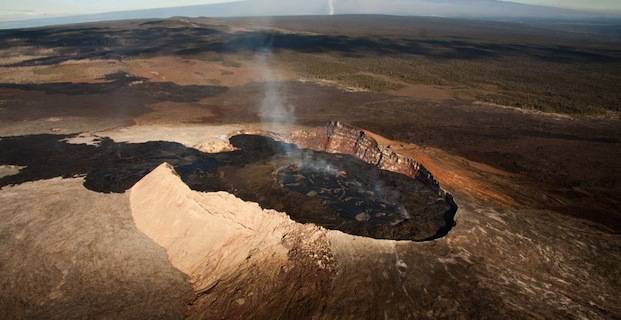Kilauea Volcano
Kilauea Volcano Facts
The Kilauea Volcano is the youngest volcano on Hawaii’s Big Island.
Because when viewed from above it seems tiny in comparison to the
neighboring volcano Mauna Loa, Kilauea was originally believed to simply
be a satellite of Mauna Loa instead of a distinct volcano. Research
that has taken place during the last decades, however, shows that not
only is Kilauea a separate volcano, but its magna-plumbing system
actually goes over 60 kilometers deep into the earth. The Kilauea
Volcano sits on a curved line made up of other volcanoes such as Kohala
and Mauna Kea.
Description
The highest point on the Kilauea Volcano is slightly less than 4,200
feet. In addition, it has a large caldera at the summit that is 3
kilometers by 5 kilometers wide at the main depression but is 6
kilometers by 6 kilometers at the outermost faults and goes down 165
meters deep. The entire area of the volcano is 552 square meters. The
oldest rocks found on the volcano date back 23,000 years and scientists
estimate that the first eruption occurred between 300,000 and 600,000
years ago. Despite this, about 90% of the basaltic shield volcano found
on the surface is made from lava flows that occurred less than 1000
years ago while 70% of the actual volcano’s surface is 600 years old or
younger. The volcano gets its name, Kilauea, from the Hawaiian word
meaning much spreading or spewing, referencing the frequent lava flows.
Nearby Wildlife
Because of the constant activity of the Kilauea Volcano, there are
semi-frequent acid rains in the nearby Ka’u Desert, a barren region to
the south of the volcano’s southwestern rift zone. Despite this,
wildlife still manages to flourish in several nearby areas, especially
those that are more or less undisturbed by the volcanic activity. In the
Hawaii Volcanoes National Park, which contains most of Kilauea’s
southern ecosystem, you will find a wide range of bird species in
addition to several endangered species of sea turtles.
Eruption History
In addition to being the youngest volcano on Hawaii’s Big Island, the
Kilauea Volcano is actually the most active of the state’s volcanoes in
recent years; in fact it is one of the most active volcanoes on the
entire planet. The volcano has been present in many Polynesian legends
and it has been almost constantly active since the first recorded
eruption which occurred around the year 1750. Most of the volcanic
activity at Kilauea between 1750 and 1924 was smaller and originated in
the lava lake found at the summit. In 1924, however, the volcano had an
explosive eruption and from then to 1955 there was a period of short
eruptions.
Current Eruption
Impressively enough, the current eruption of the Kilauea Volcano,
named Pu’u O’o started 30 years ago! It began on January 3, 1983 at
which point ground fissures opened and thin streams of molten lava
appeared from a 7 kilometer long fissure. Throughout the course of the
current eruption, the main exit point of the lava has shifted several
times. It spent the first 3.5 years erupting from a central vent but in
July of 1986, it suddenly moved down the rift 3 kilometers to the
Kupaianaha shield, where it stayed until early 1992. When the eruption
point changed, so did the style, shifting from high fountaining
occurring in episodes to a continuous but quiet effusion in a lava pond.
In November of 1986, lava from this eruption point met the ocean at a
point 12 kilometers away and covered Kapa’ahu along the way. The most
destructive phase of the Kilauea Volcano’s current eruption began in
1990 when its lava flows flooded Kalapana, a nearby village where it
destroyed more than 100 homes in just 9 months. The lava flow declined
throughout 1991 but in 1992, eruptions began once again. Now lava flows
usually come through the lava tubes and go into the ocean and there are
few surface flows.
Throughout the current eruption, lava flows have varied greatly,
ranging from 300,000 to 600,000 cubic meters each day and there were
actually 24 days during early 1997 in which there was no eruptive
activity.
Research And Preservation
At the rim of the Kilauea Volcano you will find the Hawaiian Volcano
Observatory, which was founded in 1912 by Thomas Jagger and this is
where most of the research on the volcano takes place. In addition, the
Hawaii Volcanoes National Park was created in 1916 by Woodrow Wilson.
This began the area’s path towards becoming a World Heritage Site.
Tourism
The first hotels appeared around the rim of the Kilauea Volcano in
the 1840s. After the area became a National Park in 1916, tourism
continued to increase greatly. Today around 2.6 million tourists visit
the volcano and surrounding areas each year, mostly due to its location
in beautiful Hawaii combined with its active yet docile nature.

No comments:
Post a Comment